Investigation on Moisture Damage Prevention of a Spherical Hinge Structure of a Swivel Bridge
Abstract
:1. Introduction
2. Materials and Sample Preparation
2.1. Cement
2.2. Aggregates
2.3. Fly Ash
2.4. Water-Reducing Agent
2.5. Impermeable Concrete Additive
2.6. Waterproof of Coating Materials
2.7. Impermeable Concrete Sample Preparation
3. Laboratory Test Method
3.1. Mechaincal and Imperious Properties Test of Impermeable Concrete Sample
3.1.1. Compressive Strength Test
3.1.2. Splitting Tensile Test
3.1.3. Four-Point Bending Test
3.1.4. Impermeability Test
3.2. Consolidation Performance Test of Waterproof Coating
3.2.1. Spherical Hinge Waterproof Coating Consolidation Strength Test Device
3.2.2. Consolidation Performance Test
- According to the above, standard cubic concrete specimens with a size of 100 mm × 100 mm × 100 mm are prepared and put in the curing room for 28 days under standard curing conditions. Then, the concrete specimens are removed from the curing room, and the two opposite faces of specimens are napped, respectively.
- The tested waterproof coating is smeared at the center of the two steel splints, and the coating area is consistent with the shape and size of the sides of concrete specimen, as is shown in Figure 9.
- The two sides of the concrete specimen are laminated with the coating area of steel splints to form a ‘hamburger’ firm structure. Then, the four corners of the steel splints are connected through bolts to eliminate the influence of gravity on the concrete specimen, as is shown in Figure 9. Finally, the structure is fixed on the positioning sheet of the bottom plate.
- The assembled test specimen is placed in the electronic universal testing machine, and the position of the indenter is adjusted to ensure the indenter and the upper surface of the concrete specimen are in smooth contact and in the middle. Then, the electronic universal testing machine starts to perform the test until a shear failure occurs at the steel–concrete interface. After that, the test is stopped, and the failure load F is recorded.
3.2.3. Analysis of Influencing Factors
4. Results and Discussion
4.1. Compressive Strength Test Results
4.2. Splitting Tensile Test Results
4.3. Four-Point Bending Test Results
4.4. Impermeability Test Results
4.5. Consolidation Performace Test Results of Waterproof Coating
4.5.1. Influence Analysis of Waterproof Coating Dosage
4.5.2. Influence Analysis of Temperature
4.5.3. Influence Analysis of Humidity
4.5.4. Influence Analysis of Freeze–Thaw Cycles
5. Conclusions
- The mechanical property test results of the three impermeable concretes illustrated that addition of CCCAM and PP could improve the toughness and brittleness of concrete. The compressive strength, splitting tensile strength, rupture strengths of SPC were increased by 11.8%, 24.7% and 30.4%, respectively, compared with normal concrete.
- The impermeability test results showed that the addition of CCCAM was an effective technique for improving the permeability of concrete. The relative permeability coefficient of concrete supplemented with CCCAM is reduced by 89.2% compared with normal concrete. Moreover, the incorporation of PP and CCCAM at the same time cannot improve the impermeability of concrete. This may be because the chaotic support structure formed by PP prevents the infiltration and uniform dispersion of CCCAM
- The consolidation performance test showed that temperature had a significant effect on the interface consolidation property of waterproof coatings. Moreover, the optimal dosages of SBS, PLT and UPLS waterproof coating are 1.18kg/m2, 0.95kg/m2 and 1.15kg/m2, respectively.
- From the consolidation performance test, it was understood that PLS waterproof coating maintained excellent properties in a complex environment. This is because PLS has excellent shear strength, impact resistance, flexibility and rubber characteristics, and it can form a hard–soft–hard transition layer between the concrete and steel, reduce the impact of environmental factors.
Author Contributions
Funding
Conflicts of Interest
Appendix A
| Technical Parameters | Density | Specific Surface Area | Setting Time | Compressive Strength | Flexural Strength | |||
| Initial Set | Final Set | 3d | 28d | 3d | 28d | |||
| Units | kg/m3 | m3/kg | min | min | MPa | MPa | MPa | MPa |
| Value | 3100 | 358 | 195 | 290 | 13.9 | 48.9 | 7.7 | 8.1 |
| Technical Parameters | Crushing Value | Los Angeles Attrition Rate | Mud Content | Clay Lump |
|---|---|---|---|---|
| Units | % | % | g/cm3 | % |
| Measured value | 21.2 | 25 | 2.7 | 9.3 |
| Standard value | ≤26 | ≤28 | ≥2.6 | ≤15 |
| Technical Parameters | Apparent Density | Bulk Density | Mud Content | Clay Lump |
|---|---|---|---|---|
| Units | kg/m3 | kg/m3 | % | % |
| Measured value | 2700 | 1540 | 1.6 | 0.6 |
| Standard value | ≥2500 | ≥1400 | ≤3.0 | ≤1.0 |
| Technical Parameters | Appearance | Density | Water Content | Fineness | Loss on Ignition | SO2 Content | Water Demand Ratio |
|---|---|---|---|---|---|---|---|
| Units | N/A | g/cm3 | % | % | % | % | % |
| Measured value | Cement color power | 2.4 | 0.5 | 11.3 | 3.01 | 0.27 | 93 |
| Standard value | N/A | N/A | ≤1.0 | ≤12.0 | ≤5.0 | ≤3.0 | ≤95 |
| Technical Parameters | Appearance | Particle Size | Setting Time Difference | Penetration Height Ratio | Compressive Strength | ||
| Initial Set | Final Set | 7d | 28d | ||||
| Units | N/A | μm | min | min | % | % | % |
| Value | Grey powder | 45–150 | −90–+120 | −120–+120 | ≤40 | ≥100 | ≥95 |
| Technical Parameters | Diameter | Length | Density | Elastic Modulus | Breaking Strength | Breaking Elongation |
|---|---|---|---|---|---|---|
| Units | μm | mm | g/cm3 | GPa | MPa | % |
| Value | 26 | 8–12 | 1.3 | 36 | 1280 | 5 |
| Technical Index | Unit | Measured Value | Standard Value | Test Method | |
|---|---|---|---|---|---|
| 25 °C Penetration | 0.1mm | 55.1 | 40–60 | GB/T0604-2011 | |
| PI | N/A | 0.198 | ≥0 | GB/T0604-2011 | |
| Softening point | °C | 86.5 | ≥60 | GB/T0606-2011 | |
| 5 °C Ductility | cm | 31.7 | ≥20 | GB/T0605-2011 | |
| 135 °C Brinell rotational viscosity | Pa·s | 1.838 | ≤3 | GB/T0625-2011 | |
| Flash point | °C | 330 | ≥230 | GB/T0611-2011 | |
| Solubility | % | 99.80 | ≥99 | GB/T0607-2011 | |
| 25 °C elastic rebound rate | % | 90 | ≥75 | GB/T0662-2011 | |
| Density | g/cm3 | 1.05 | N/A | GB/T0603-2011 | |
| The rolling thin film oven test | Mass loss rate | % | 0.07 | N/A | GB/T0609-2011 |
| Residual penetration ratio | % | 72.1 | N/A | GB/T0604-2011 | |
| Residual ductility | cm | 38.1 | N/A | GB/T0605-2011 | |
| Technical Index | Unit | Measured Value | Standard Value |
|---|---|---|---|
| Appearance | N/A | Uniform viscous body, no gel or lumps | Uniform viscous body, no gel or lumps |
| Solid content | % | 89.8 | ≥85.0 |
| Surface drying time | h | 6 | ≤12 |
| Hard drying time | h | 11 | ≤24 |
| Tensile strength | MPa | 2.51 | ≥2.00 |
| Breaking elongation | % | 607 | ≥500 |
| Tear strength | N/mm | 18 | ≥15 |
| Low temperature bending resistance | N/A | No cracks (−35 °C) | No cracks |
| Permeability | N/A | Impermeable (0.3 MPa, 120 min) | Impermeable |
| Heating expansion rate | % | −2.2 | −4.0–+1.0 |
| Bonding strength | MPa | 1.2 | ≥1.0 |
| Water absorption | % | 3.0 | ≤5.0 |
| Technical Index | Unit | Measured Value | Standard Value |
|---|---|---|---|
| Appearance | N/A | Colorless transparent liquid | N/A |
| Chroma (Pt-C0) | N/A | 25–35 | GB/T 7193.7-2008 |
| Acid value | mgKOH/g | 15–25 | GB/T 2895-2008 |
| Solid content | % | 60–80 | GB/T 7193.3-2008 |
| 25 °C viscosity | mPa·s | 350–600 | GB/T 7193.1-2008 |
| Solidification time | min | 20–30 | GB/T 7193.6-2008 |
| 80 °C stability | h | ≥24 | GB/T 7193.5-2008 |
| Technical Index | Unit | Measured Value | Standard Value |
|---|---|---|---|
| Appearance | N/A | No defects | N/A |
| Tensile strength | MPa | 67 | GB/T 2568-2008 |
| Tensile elastic modulus | MPa | 3500 | GB/T 2568-2008 |
| Breaking elongation | % | 2.50 | GB/T 2568-2008 |
| Bending strength | MPa | 100 | GB/T 2570-2008 |
| Flexural modulus | MPa | 3700 | GB/T 2570-2008 |
| Impact toughness | KJ/m2 | 10.0 | GB/T 2571-2008 |
| Thermal distortion temperature | °C | 65 | GB/T 1634-2008 |
| Barcol hardness | Barcol | 45 | GB/T 3854-2008 |
References
- Guo, Z.H.; Zhang, Z. Erection of pearl bridge by bear angle vertical swivel method. Adv. Mater. Res. 2010, 163, 1–7. [Google Scholar] [CrossRef]
- Zhou, Z.X.; Li, F.; Imbsen, R. Vertical erection-rotation method for chorded arch bridge. Struct. Eng. Int. 2009, 19, 142–148. [Google Scholar] [CrossRef]
- Li, W.W.; Zhang, Z.; Huang, C.L. Application of dynamic unstressed state method in vertical rotation construction of bridges. Adv. Mater. Res. 2011, 255, 988–992. [Google Scholar] [CrossRef]
- Wang, S.J.; Zhou, X. Application of CAD and finite element method in the gravity center analysis of body rotating cable-stayed bridge. Adv. Mater. Res. 2011, 243, 1549–1552. [Google Scholar] [CrossRef]
- Che, X.; Zhang, X. Overturning resistance of large tonnage T-shaped rigid frame bridge during turning. J. China Highw. 2014, 27, 66–72. [Google Scholar]
- Du, J. Innovation and prospect of bridge rotation construction technology. J. Railw. Constr. Technol. 2012, 4, 7–11. [Google Scholar]
- Gharpure, D.R.; Biyani, S.R. Poira bridge: Construction of India’s first horizontal swing bridge. Indian Concr. J. 2007, 81, 33–35. [Google Scholar]
- Siwowski, T.; Wysocki, A. Horizontal rotation via floatation as an accelerated bridge construction for long-span footbridge erection: Case study. J. Bridge. Eng. 2014, 20, 05014014. [Google Scholar] [CrossRef]
- Hu, J.; Sun, X.Y.; Jiao, S.J. Monitoring of long-span self-anchored arch bridge constructed with rotation method. Appl. Mech. Mater. 2012, 178, 1977–1982. [Google Scholar] [CrossRef]
- Feng, Y.; Qi, J.N.; Wang, J.Q. Rotation construction of heavy swivel arch bridge for high-speed railway. Structures 2020, 26, 755–764. [Google Scholar] [CrossRef]
- Sun, Q.S.; Guo, X.G.; Zhang, D.P. Research on the application of horizontal rotation construction method with flat hinge in cable-stayed bridge construction. Adv. Mater. Res. 2011, 255, 856–860. [Google Scholar] [CrossRef]
- Gao, R.; Hu, Z.; Gao, T.M. Analysis of influence of train-induced vibration on the stability of swivel construction bridge. Railway Constr. 2014, 5, 16–18. [Google Scholar]
- Xiao, J.; Liu, M.; Zhong, T.; Fu, G. Seismic performance analysis of concrete-filled steel tubular single pylon cable-stayed bridge with swivel construction. IOP. Conf. Ser. Earth Environ. Sci. 2019, 218, 012087. [Google Scholar] [CrossRef]
- Almusallam, A.A.; Khan, F.M.; Dulajan, S.U.; Al-Amoudi, O.S.B. Effectiveness of surface coatings in improving concrete durability. Cem. Concr. Compos. 2003, 25, 473–481. [Google Scholar] [CrossRef]
- Zhao, Z.G.; Qu, X.L.; Li, J.H. Application of polymer modified cementitious coatings (PCCs) for impermeability enhancement of concrete. Constr. Build. Mater. 2020, 249, 118769. [Google Scholar] [CrossRef]
- Huang, B.C.; Wu, H.; Shu, X.; Burdette, E.G. Laboratory evaluation of permeability and strength of polymer-modified pervious concrete. Constr. Build. Mater. 2010, 24, 818–823. [Google Scholar] [CrossRef]
- Liu, B.J.; Shi, J.K.; Sun, M.H.; He, Z.; Xu, H.; Tan, J. Mechanical and permeability properties of polymer-modified concrete using hydrophobic agent. J. Build. Eng. 2020, 31, 101337. [Google Scholar] [CrossRef]
- Zhang, S.P.; He, P.L.; Niu, L.L. Mechanical properties and permeability of fiber-reinforced concrete with recycled aggregate made from waste clay brick. J. Cleaner Prod. 2020, 268, 121690. [Google Scholar] [CrossRef]
- Guo, Y.H.; Zhang, P.Y.; Ding, H.Y. Experimental study on the permeability of SAP modified concrete. Materials 2020, 13, 3368. [Google Scholar] [CrossRef]
- Liu, M.M.; Han, S.; Pan, J.; Ren, W. Study on cohesion performance of waterborne epoxy resin emulsified asphalt as interlayer materials. Constr. Build. Mater. 2018, 177, 72–82. [Google Scholar] [CrossRef]
- Rhee, J.; Kim, H.; Ock, C. An investigation of the deterioration characteristics of concrete bridge decks with asphalt concrete in Korea. KSCE J. Civ. Eng. 2018, 22, 613–621. [Google Scholar] [CrossRef]
- Zhang, Y.T.; Zuo, L.; Yang, J.C.; Cai, X.N.; Zhao, Y.; Zeng, X. Effect of cementitious capillary crystalline waterproofing coating on the gas permeability of mortar. Struct. Concr. 2019, 20, 1763–1770. [Google Scholar] [CrossRef]
- Al-Kheetan, M.J.; Rahman, M.M.; Chamberlain, D.A. A novel approach of introducing crystalline protection material and curing agent in fresh concrete for enhancing hydrophobicity. Constr. Build. Mater. 2018, 160, 644–652. [Google Scholar] [CrossRef]
- Al-Kheetan, M.J.; Rahman, M.M.; Chamberlain, D.A. Remediation and protection of masonry structures with crystallising moisture blocking treatment. Int. J. Build. Pathol. Adapt. 2018, 36, 77–92. [Google Scholar] [CrossRef]
- Karpov, A.I. Theses in the area of nanotechnologies and nanomaterials: Novelties and practical application. Part 2. Nanotechnol. Constr. Sci. Int. J. 2016, 8, 82–103. [Google Scholar] [CrossRef]
- Shen, D.J.; Wen, C.Y.; Zhu, P.F.; Wu, Y.; Yuan, J. Influence of Barchip fiber on early-age autogenous shrinkage of high strength concrete. Constr. Build. Mater. 2020, 256, 119223. [Google Scholar] [CrossRef]
- Ahmed, T.W.; Ali, A.A.M.; Zidan, R.S. Properties of high strength polypropylene fiber concrete containing recycled aggregate. Constr. Build. Mater. 2020, 241, 118010. [Google Scholar] [CrossRef]
- Chen, J.; Ma, X.; Wang, H.; Xie, P.; Huang, W. Experimental study on anti-icing and deicing performance of polyurethane concrete as road surface layer. Constr. Build. Mater. 2018, 161, 598–605. [Google Scholar] [CrossRef]
- Marukha, V.I.; Serednyts’kyi, Y.A. Specific features of injection hardening of cracked concrete structures and buildings with polyurethanes. Mater. Sci. 2008, 44, 720–725. [Google Scholar] [CrossRef]
- Zeng, L.M.; Wang, S.P. Mechanism and effectiveness of reduction action of unsaturated polyester resin reducer. J. Wuhan Univ. Technol. Mater. Sci. Ed. 2001, 16, 70–74. [Google Scholar]
- Penczek, P.; Boncza-Tomaszewski, Z. Unsaturated polyester resins on the verge of the 21st century. Polimery 1999, 44, 709–715. [Google Scholar] [CrossRef]
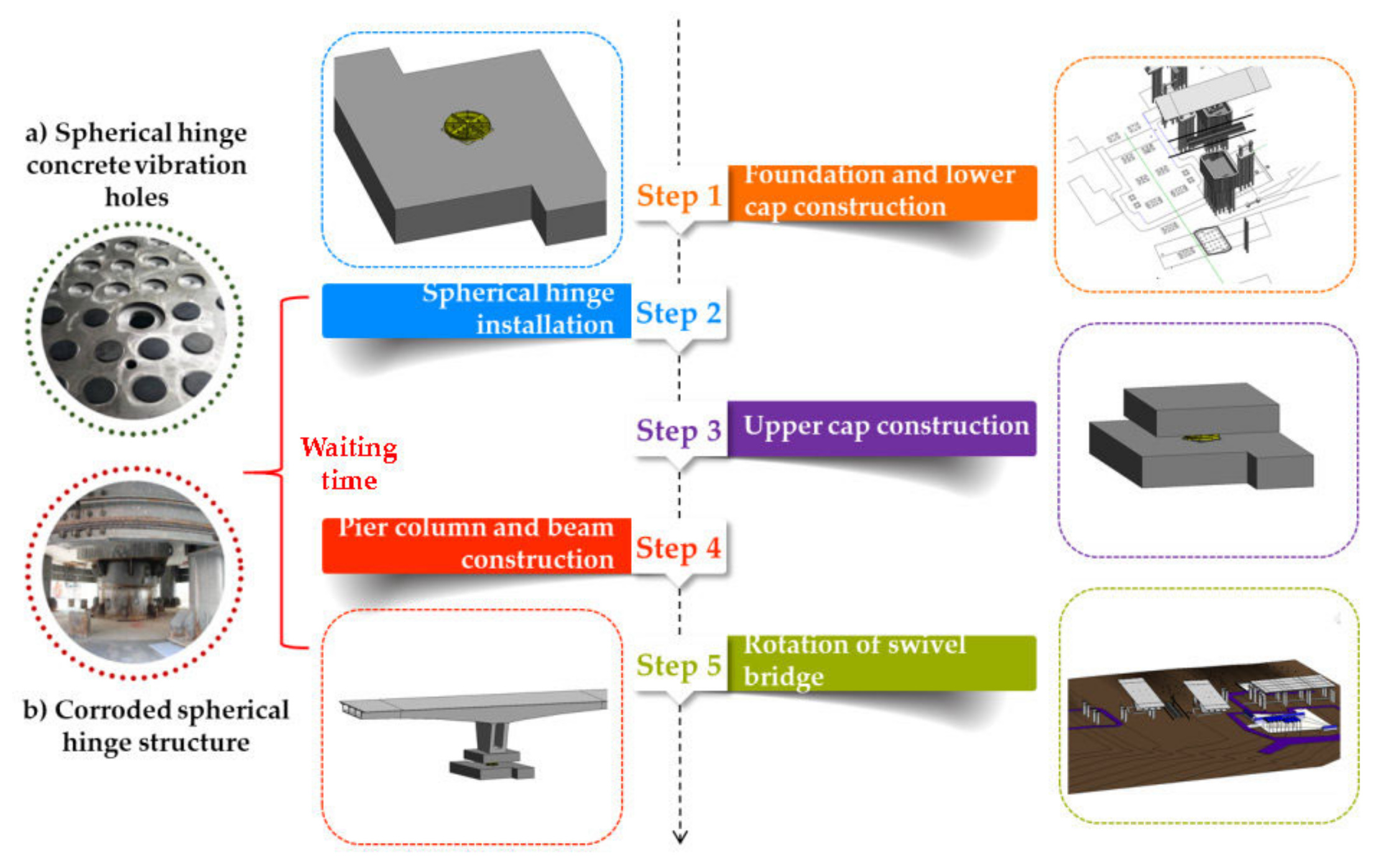

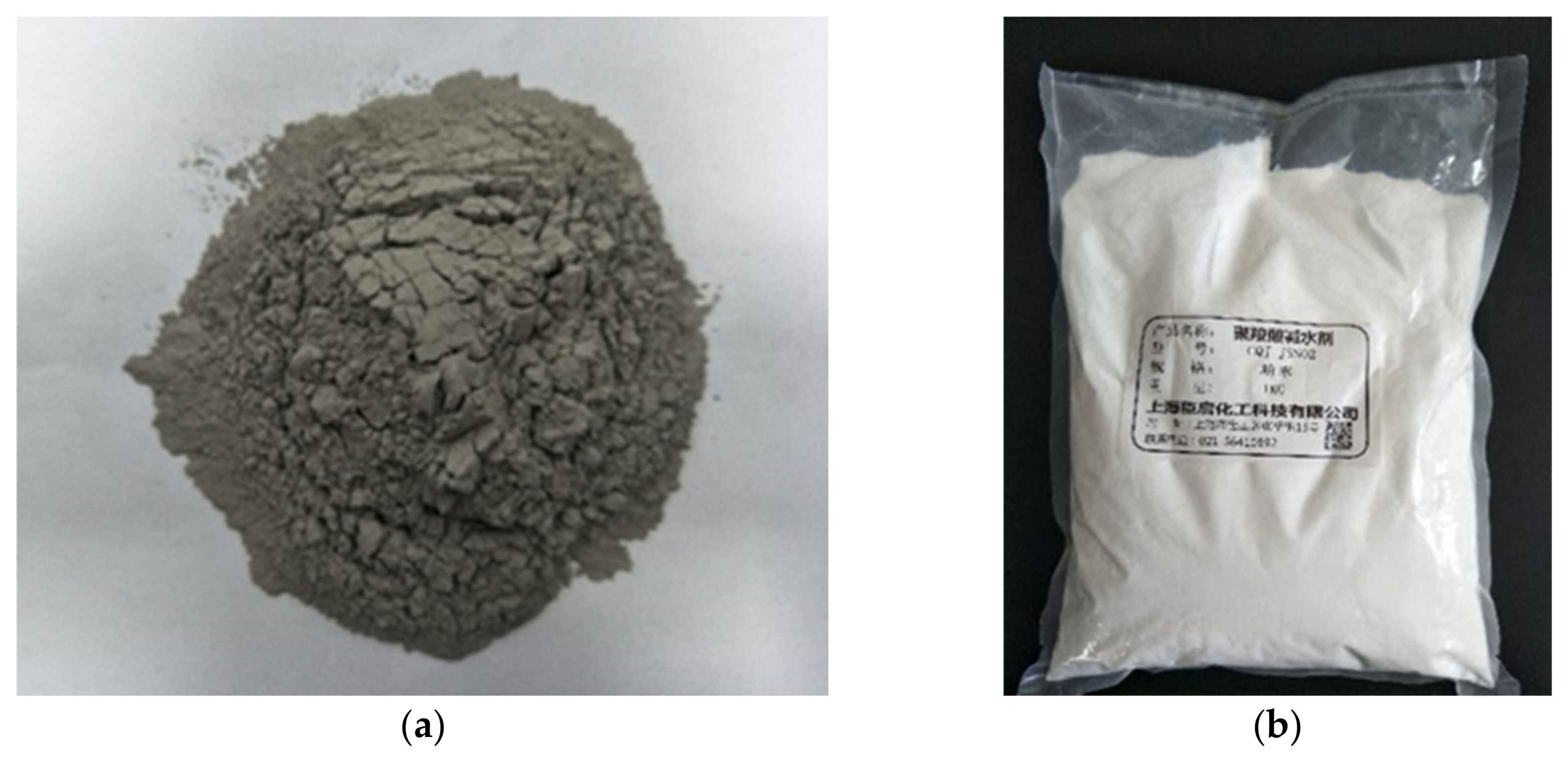
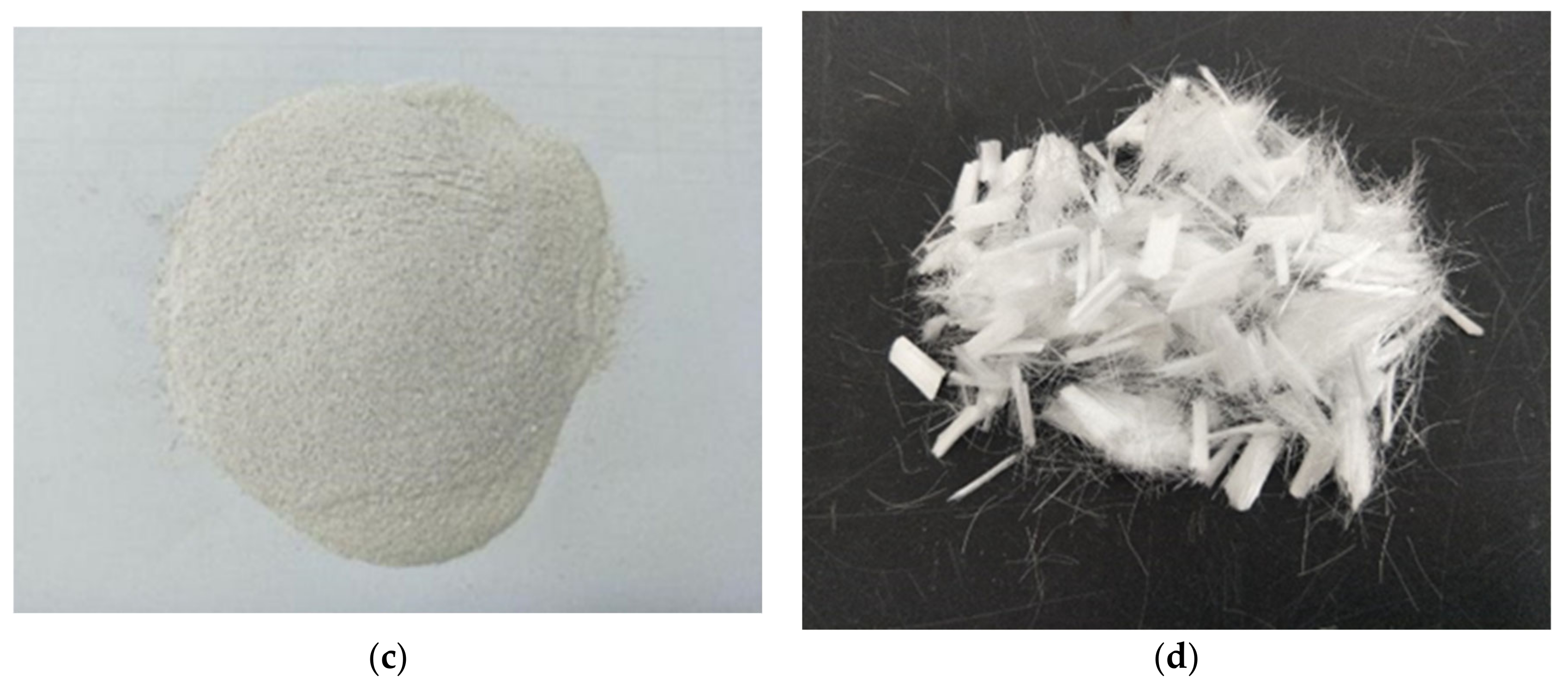
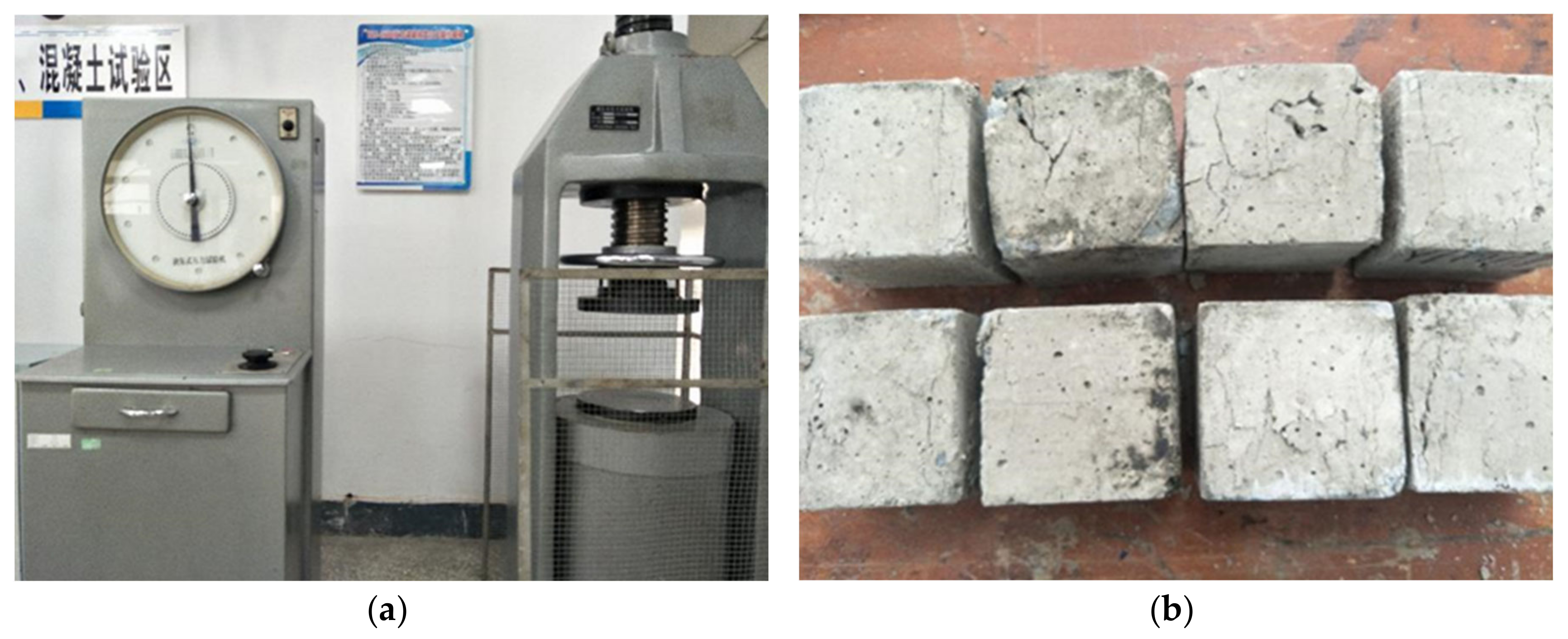
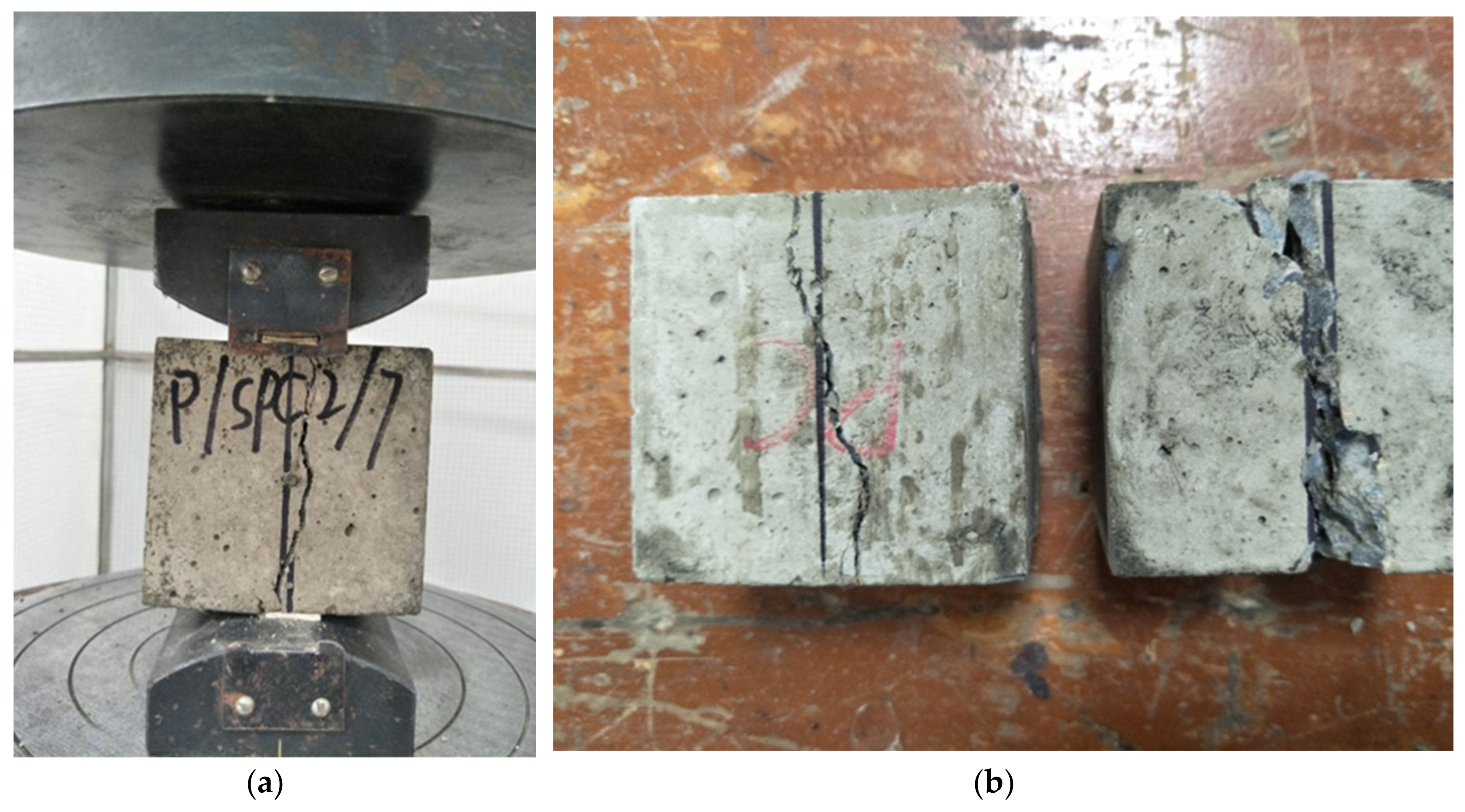

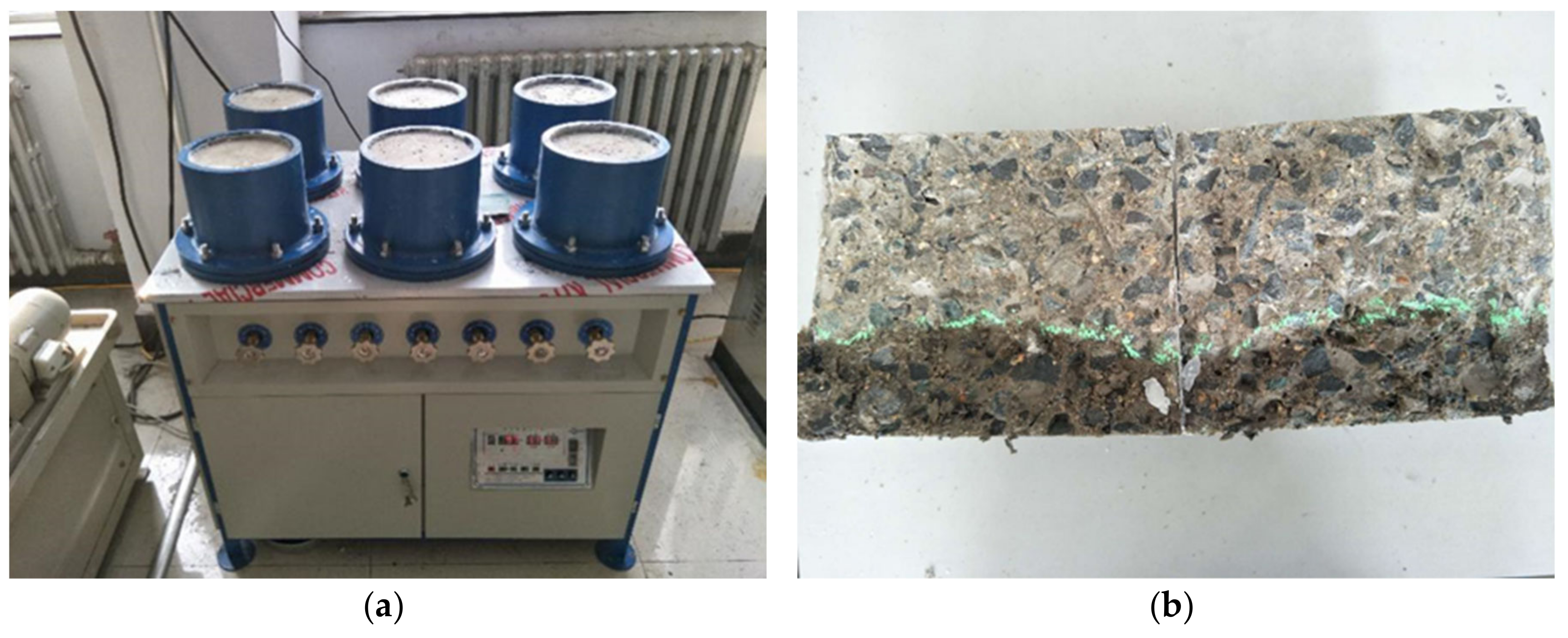
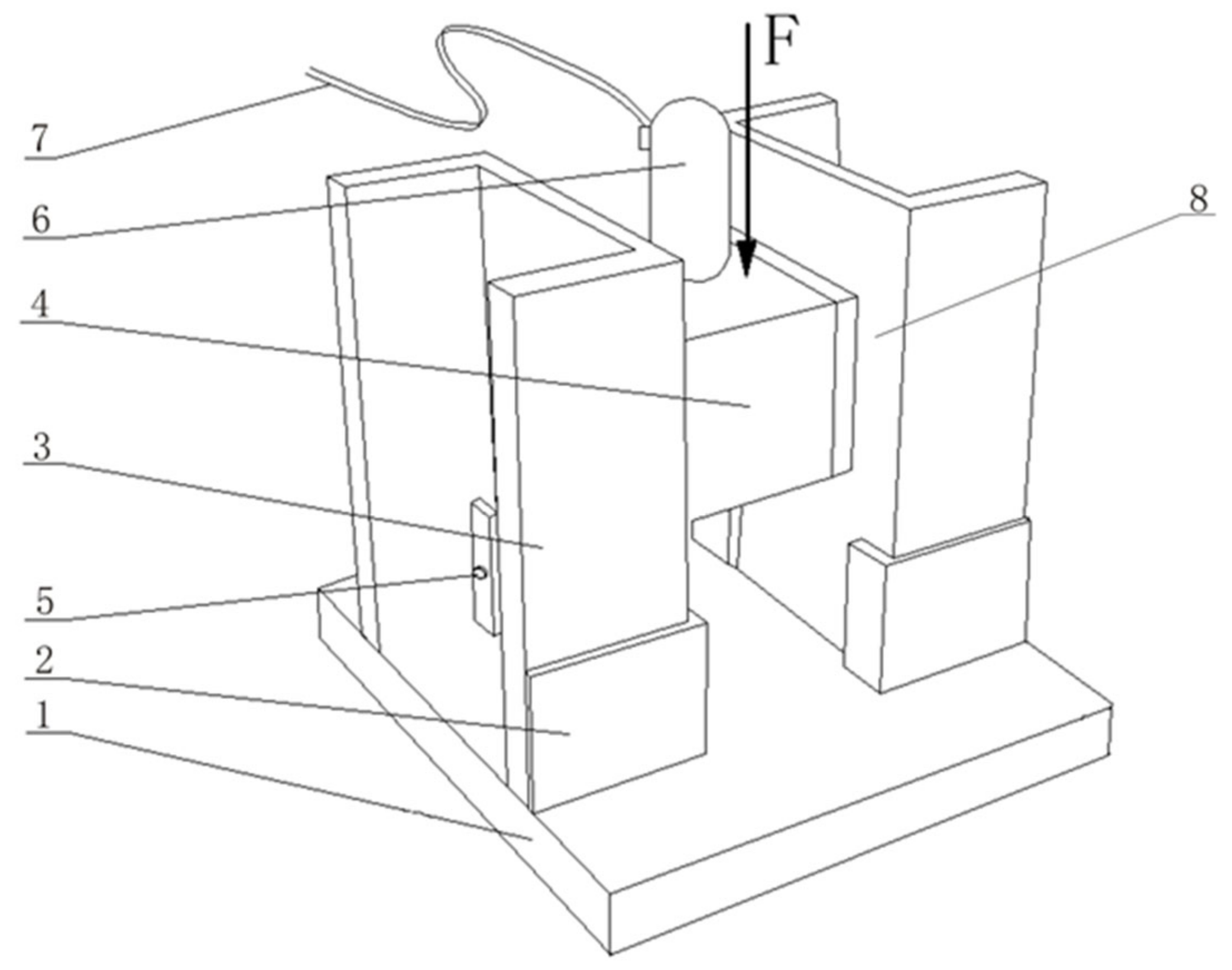



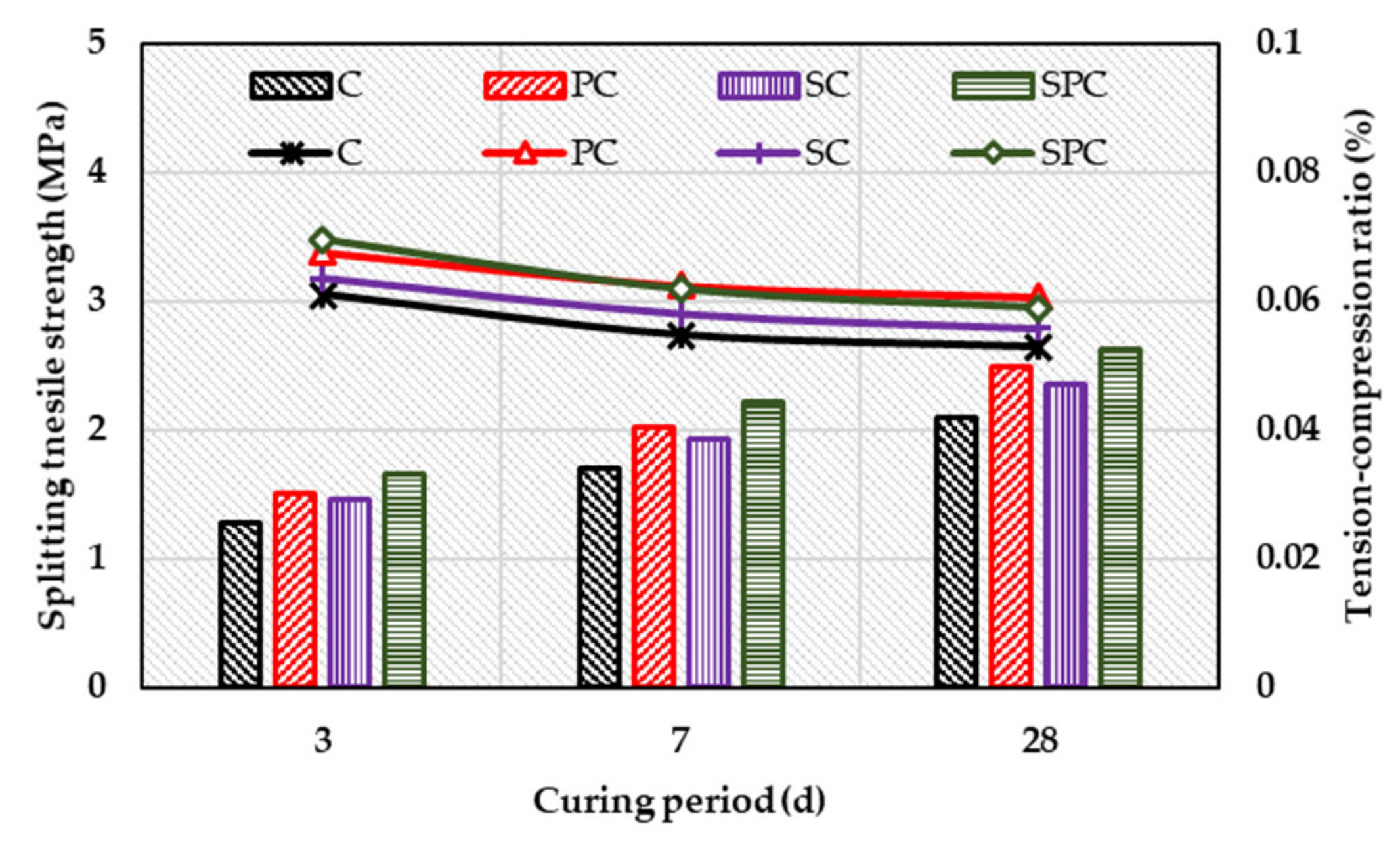
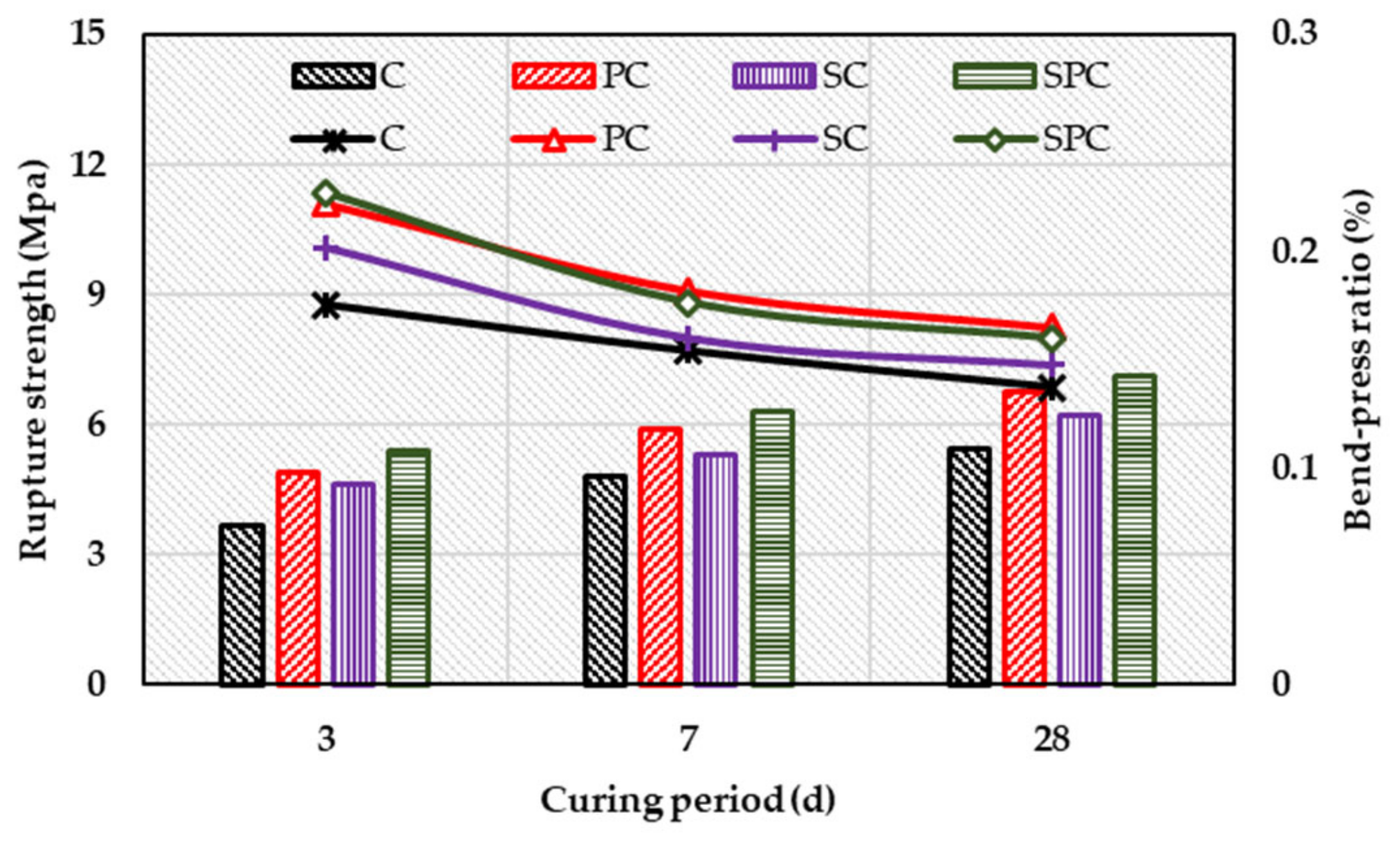


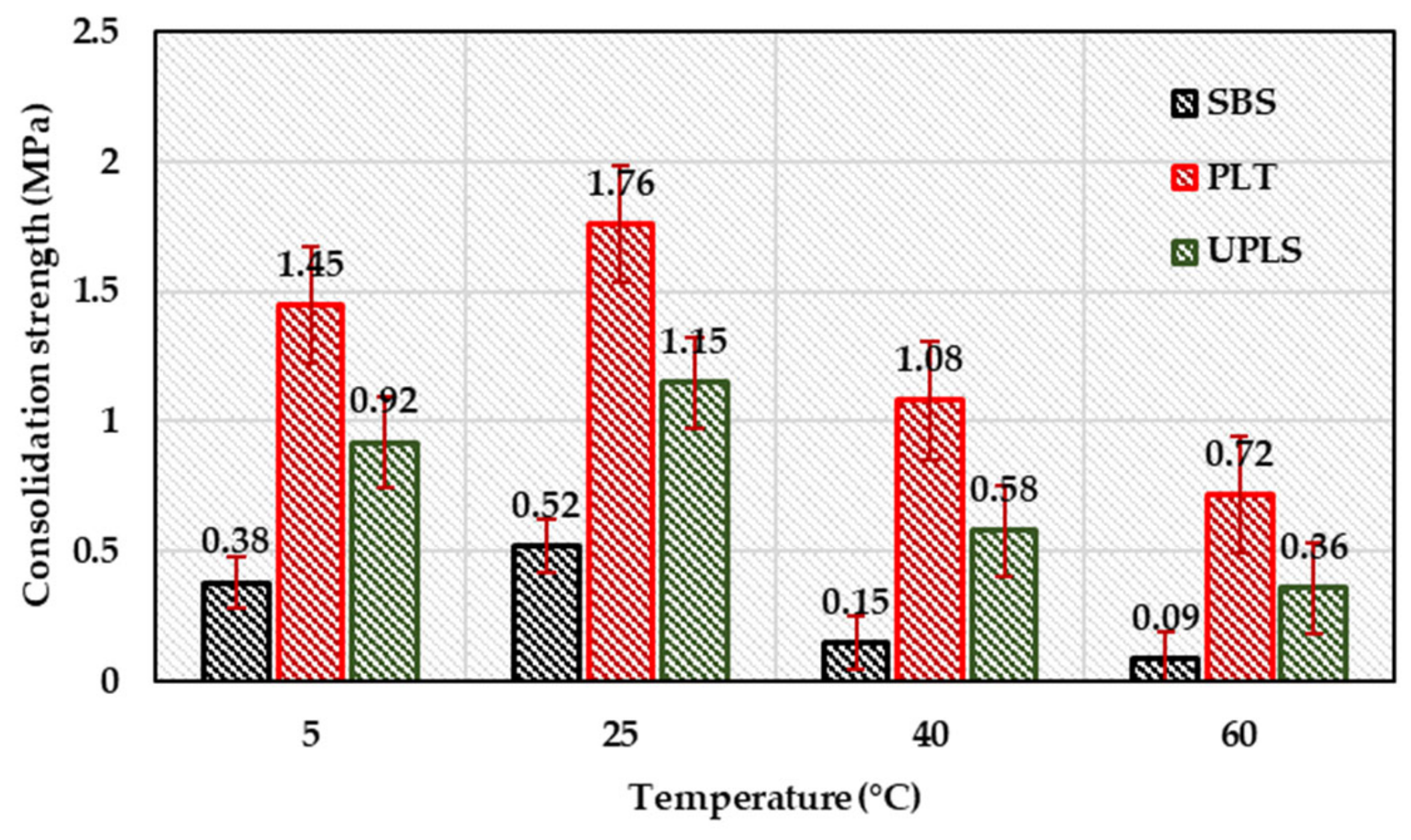
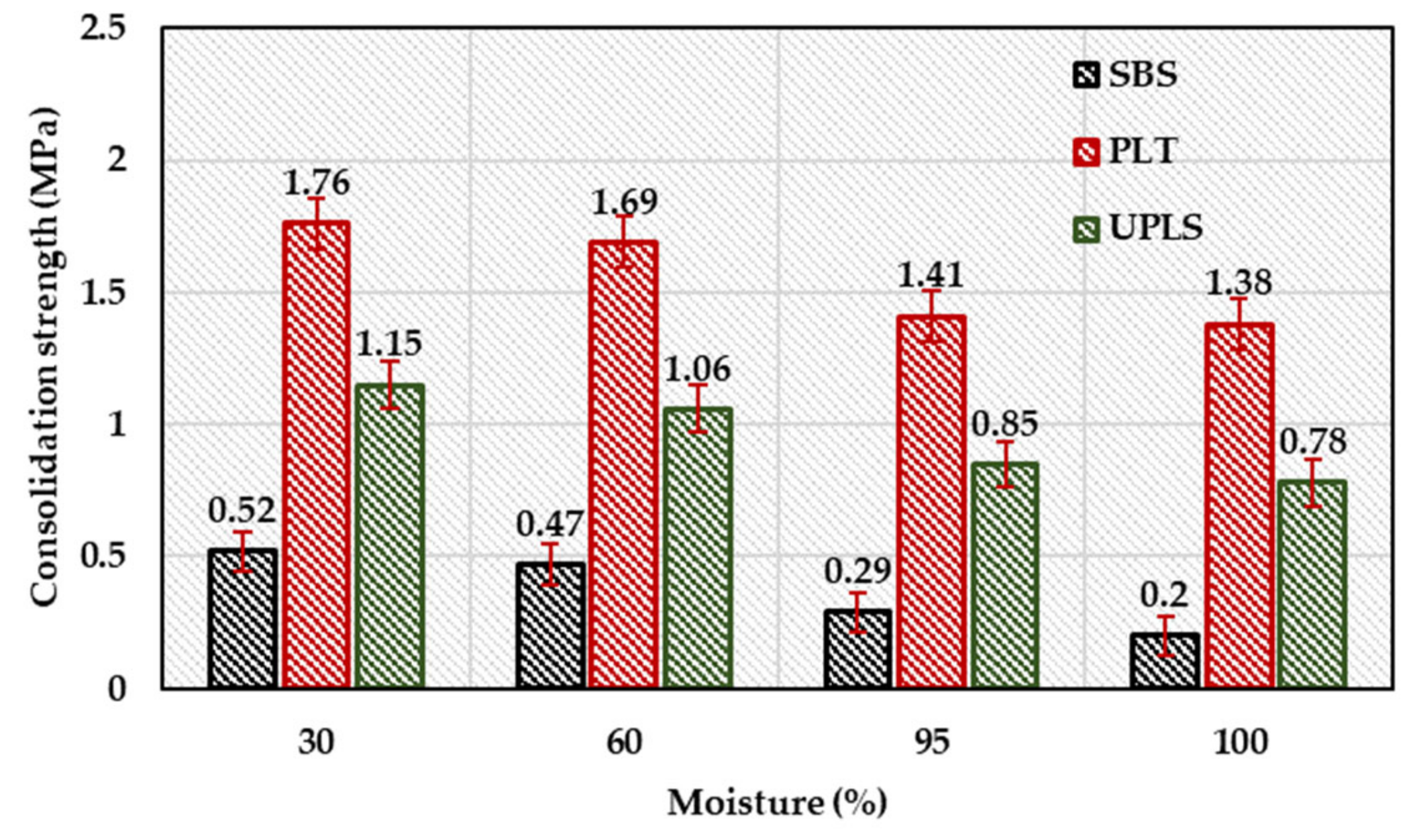
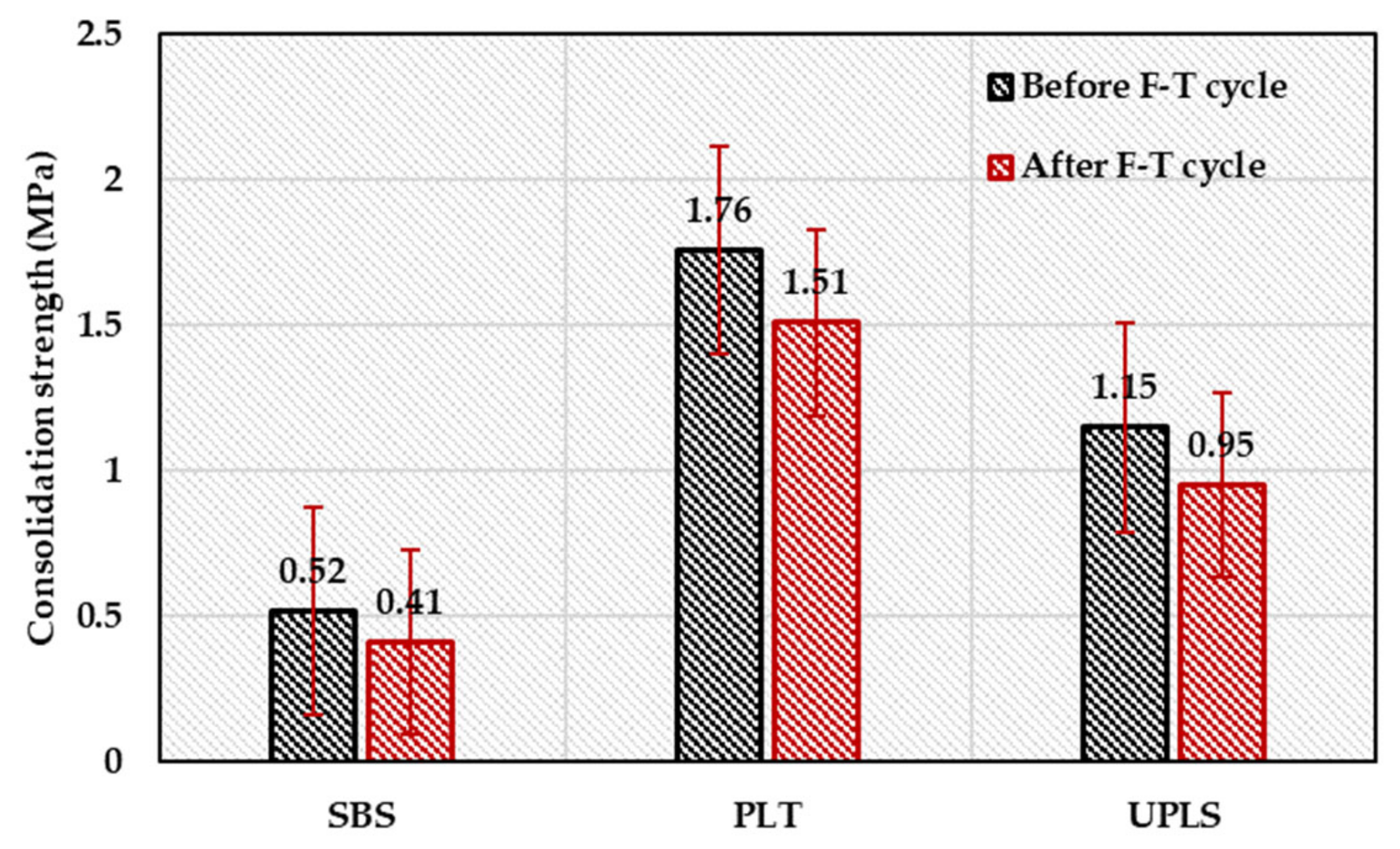
| Type | Coarse Aggregate | Sand | Cement | Fly Ash | Superplasticizer | Water | PP | CCCAM |
|---|---|---|---|---|---|---|---|---|
| C | 1280 | 690 | 325 | 58.5 | 0.65 | 156 | N/A | N/A |
| PC | 1280 | 690 | 325 | 58.5 | 0.65 | 156 | 0.9 | N/A |
| SC | 1280 | 690 | 325 | 58.5 | 0.65 | 156 | N/A | 6.5 |
| SPC | 1280 | 690 | 325 | 58.5 | 0.65 | 156 | 0.9 | 6.5 |
© 2020 by the authors. Licensee MDPI, Basel, Switzerland. This article is an open access article distributed under the terms and conditions of the Creative Commons Attribution (CC BY) license (http://creativecommons.org/licenses/by/4.0/).
Share and Cite
Guo, W.; Guo, X.; Wang, Z.; Li, Z. Investigation on Moisture Damage Prevention of a Spherical Hinge Structure of a Swivel Bridge. Coatings 2020, 10, 955. https://doi.org/10.3390/coatings10100955
Guo W, Guo X, Wang Z, Li Z. Investigation on Moisture Damage Prevention of a Spherical Hinge Structure of a Swivel Bridge. Coatings. 2020; 10(10):955. https://doi.org/10.3390/coatings10100955
Chicago/Turabian StyleGuo, Wei, Xuedong Guo, Ziwen Wang, and Zhun Li. 2020. "Investigation on Moisture Damage Prevention of a Spherical Hinge Structure of a Swivel Bridge" Coatings 10, no. 10: 955. https://doi.org/10.3390/coatings10100955





